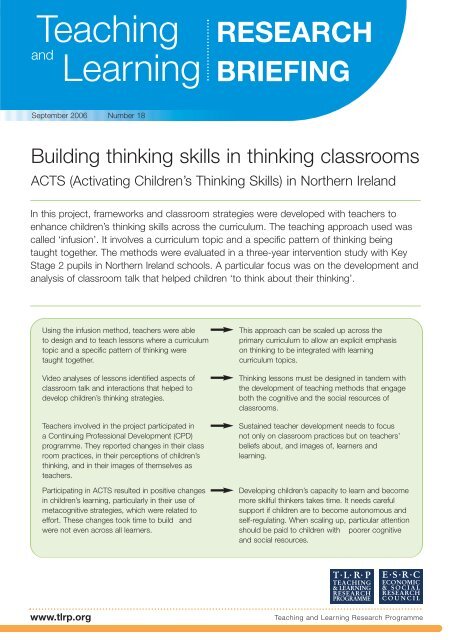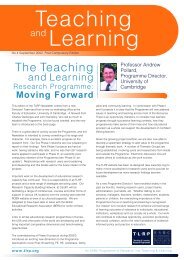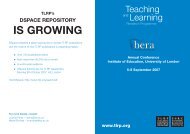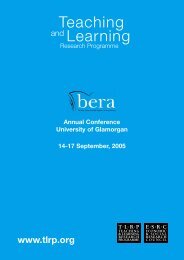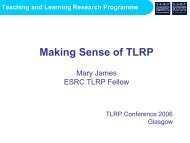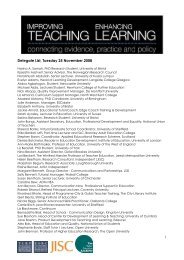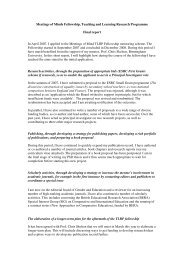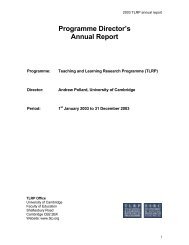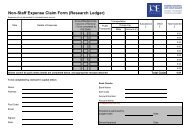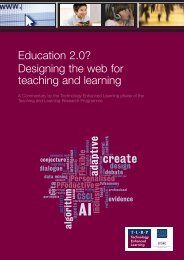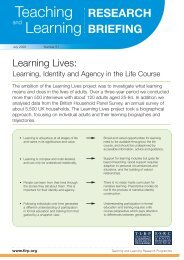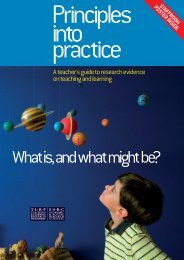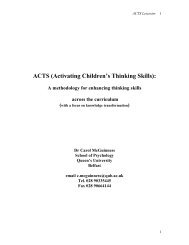Building thinking skills in thinking classrooms - Teaching and ...
Building thinking skills in thinking classrooms - Teaching and ...
Building thinking skills in thinking classrooms - Teaching and ...
You also want an ePaper? Increase the reach of your titles
YUMPU automatically turns print PDFs into web optimized ePapers that Google loves.
Teach<strong>in</strong>g<br />
Learn<strong>in</strong>g<br />
<strong>and</strong><br />
RESEARCH<br />
BRIEFING<br />
September 2006 Number 18<br />
<strong>Build<strong>in</strong>g</strong> <strong>th<strong>in</strong>k<strong>in</strong>g</strong> <strong>skills</strong> <strong>in</strong> <strong>th<strong>in</strong>k<strong>in</strong>g</strong> <strong>classrooms</strong><br />
ACTS (Activat<strong>in</strong>g Children’s Th<strong>in</strong>k<strong>in</strong>g Skills) <strong>in</strong> Northern Irel<strong>and</strong><br />
In this project, frameworks <strong>and</strong> classroom strategies were developed with teachers to<br />
enhance children’s <strong>th<strong>in</strong>k<strong>in</strong>g</strong> <strong>skills</strong> across the curriculum. The teach<strong>in</strong>g approach used was<br />
called ‘<strong>in</strong>fusion’. It <strong>in</strong>volves a curriculum topic <strong>and</strong> a specific pattern of <strong>th<strong>in</strong>k<strong>in</strong>g</strong> be<strong>in</strong>g<br />
taught together. The methods were evaluated <strong>in</strong> a three-year <strong>in</strong>tervention study with Key<br />
Stage 2 pupils <strong>in</strong> Northern Irel<strong>and</strong> schools. A particular focus was on the development <strong>and</strong><br />
analysis of classroom talk that helped children ‘to th<strong>in</strong>k about their <strong>th<strong>in</strong>k<strong>in</strong>g</strong>’.<br />
Us<strong>in</strong>g the <strong>in</strong>fusion method, teachers were able<br />
to design <strong>and</strong> to teach lessons where a curriculum<br />
topic <strong>and</strong> a specific pattern of <strong>th<strong>in</strong>k<strong>in</strong>g</strong> were<br />
taught together.<br />
Video analyses of lessons identified aspects of<br />
classroom talk <strong>and</strong> <strong>in</strong>teractions that helped to<br />
develop children’s <strong>th<strong>in</strong>k<strong>in</strong>g</strong> strategies.<br />
Teachers <strong>in</strong>volved <strong>in</strong> the project participated <strong>in</strong><br />
a Cont<strong>in</strong>u<strong>in</strong>g Professional Development (CPD)<br />
programme. They reported changes <strong>in</strong> their class<br />
room practices, <strong>in</strong> their perceptions of children’s<br />
<strong>th<strong>in</strong>k<strong>in</strong>g</strong>, <strong>and</strong> <strong>in</strong> their images of themselves as<br />
teachers.<br />
Participat<strong>in</strong>g <strong>in</strong> ACTS resulted <strong>in</strong> positive changes<br />
<strong>in</strong> children’s learn<strong>in</strong>g, particularly <strong>in</strong> their use of<br />
metacognitive strategies, which were related to<br />
effort. These changes took time to build <strong>and</strong><br />
were not even across all learners.<br />
This approach can be scaled up across the<br />
primary curriculum to allow an explicit emphasis<br />
on <strong>th<strong>in</strong>k<strong>in</strong>g</strong> to be <strong>in</strong>tegrated with learn<strong>in</strong>g<br />
curriculum topics.<br />
Th<strong>in</strong>k<strong>in</strong>g lessons must be designed <strong>in</strong> t<strong>and</strong>em with<br />
the development of teach<strong>in</strong>g methods that engage<br />
both the cognitive <strong>and</strong> the social resources of<br />
<strong>classrooms</strong>.<br />
Susta<strong>in</strong>ed teacher development needs to focus<br />
not only on classroom practices but on teachers’<br />
beliefs about, <strong>and</strong> images of, learners <strong>and</strong><br />
learn<strong>in</strong>g.<br />
Develop<strong>in</strong>g children’s capacity to learn <strong>and</strong> become<br />
more skilful th<strong>in</strong>kers takes time. It needs careful<br />
support if children are to become autonomous <strong>and</strong><br />
self-regulat<strong>in</strong>g. When scal<strong>in</strong>g up, particular attention<br />
should be paid to children with poorer cognitive<br />
<strong>and</strong> social resources.<br />
www.tlrp.org<br />
Teach<strong>in</strong>g <strong>and</strong> Learn<strong>in</strong>g Research Programme
The research<br />
It is generally agreed that children cannot<br />
become better th<strong>in</strong>kers – able to give<br />
reasons for their conclusions, to th<strong>in</strong>k flexibly<br />
<strong>and</strong> creatively, to solve problems <strong>and</strong> make<br />
good decisions – solely by learn<strong>in</strong>g a<br />
content-based curriculum. We must make<br />
clear what we mean by these different forms<br />
of <strong>th<strong>in</strong>k<strong>in</strong>g</strong> <strong>and</strong> set out to teach them more<br />
explicitly than we normally do <strong>in</strong> <strong>classrooms</strong>.<br />
Various models of <strong>th<strong>in</strong>k<strong>in</strong>g</strong> can be used to<br />
guide such teach<strong>in</strong>g. A core dist<strong>in</strong>ction<br />
is between ‘enrichment’ <strong>and</strong> ‘<strong>in</strong>fusion’<br />
approaches. Enrichment approaches<br />
generally draw on a specific cognitive theory.<br />
Lessons are pre-designed <strong>and</strong> are taught <strong>in</strong><br />
parallel with exist<strong>in</strong>g ones. Examples <strong>in</strong>clude<br />
Cognitive Acceleration programmes <strong>and</strong><br />
Instrumental Enrichment. In contrast, <strong>in</strong>fusion<br />
approaches place <strong>th<strong>in</strong>k<strong>in</strong>g</strong> <strong>in</strong> the context<br />
of normal curricular topics so that topic<br />
underst<strong>and</strong><strong>in</strong>g <strong>and</strong> <strong>th<strong>in</strong>k<strong>in</strong>g</strong> can be taught<br />
simultaneously. Infusion can be subjectspecific<br />
(science, mathematics, history) or<br />
may be developed on a wider scale across<br />
the curriculum.<br />
It has been argued that <strong>in</strong>fusion across the<br />
curriculum is a good strategy for develop<strong>in</strong>g<br />
‘<strong>in</strong>telligent’ novices who can recognise <strong>and</strong><br />
use common patterns of <strong>th<strong>in</strong>k<strong>in</strong>g</strong>, deepen<br />
their underst<strong>and</strong><strong>in</strong>g of curriculum topics,<br />
make connections between them, <strong>and</strong> thus<br />
be a position to capitalise on new learn<strong>in</strong>g<br />
opportunities. ACTS (Activat<strong>in</strong>g Children’s<br />
Th<strong>in</strong>k<strong>in</strong>g Skills) adopted an <strong>in</strong>fusion approach<br />
<strong>and</strong> built on the work of Robert Swartz <strong>and</strong><br />
David Perk<strong>in</strong>s <strong>in</strong> the US.<br />
Figure 1 shows the ACTS <strong>th<strong>in</strong>k<strong>in</strong>g</strong><br />
framework. It <strong>in</strong>cludes a range of different<br />
types of <strong>th<strong>in</strong>k<strong>in</strong>g</strong>. They <strong>in</strong>clude patternmak<strong>in</strong>g<br />
through analys<strong>in</strong>g wholes <strong>and</strong> parts<br />
<strong>and</strong> similarities <strong>and</strong> differences, mak<strong>in</strong>g<br />
predictions <strong>and</strong> justify<strong>in</strong>g conclusions,<br />
reason<strong>in</strong>g about cause <strong>and</strong> effect, generat<strong>in</strong>g<br />
ideas <strong>and</strong> possibilities, see<strong>in</strong>g multiple<br />
perspectives, solv<strong>in</strong>g problems <strong>and</strong><br />
evaluat<strong>in</strong>g solutions, weigh<strong>in</strong>g up pros <strong>and</strong><br />
cons, <strong>and</strong> mak<strong>in</strong>g decisions. The types of<br />
<strong>th<strong>in</strong>k<strong>in</strong>g</strong> identified <strong>in</strong> the framework formed<br />
the basis for design<strong>in</strong>g <strong>in</strong>fusion lessons.<br />
At the heart of the framework is a different<br />
type of <strong>th<strong>in</strong>k<strong>in</strong>g</strong> – metacognition.<br />
Metacognition refers to learners’ capacity not<br />
only to engage <strong>in</strong> these explicit forms of<br />
<strong>th<strong>in</strong>k<strong>in</strong>g</strong> but also to use their emergent<br />
knowledge about <strong>th<strong>in</strong>k<strong>in</strong>g</strong> to plan, monitor<br />
Figure 1: ACTS <strong>th<strong>in</strong>k<strong>in</strong>g</strong> framework<br />
<strong>and</strong> adjust their future learn<strong>in</strong>g <strong>and</strong> <strong>th<strong>in</strong>k<strong>in</strong>g</strong>.<br />
Thus metacognition has potential to facilitate<br />
the transfer of learn<strong>in</strong>g. One of the primary<br />
development goals of the ACTS project was<br />
to build a metacognitively-rich pedagogy to<br />
support children’s learn<strong>in</strong>g <strong>and</strong> <strong>th<strong>in</strong>k<strong>in</strong>g</strong> so<br />
that they would be better placed to plan,<br />
monitor <strong>and</strong> appraise their own <strong>th<strong>in</strong>k<strong>in</strong>g</strong>.<br />
What happened <strong>in</strong> the project<br />
<strong>and</strong> what did we f<strong>in</strong>d<br />
Three <strong>in</strong>terrelated str<strong>and</strong>s of <strong>in</strong>vestigation<br />
were pursued. In the first, a professional<br />
development programme was constructed to<br />
enable teachers to design <strong>in</strong>fusion lessons<br />
<strong>and</strong> to engage with the classroom practices<br />
associated with the ACTS pedagogy. In the<br />
second str<strong>and</strong>, <strong>th<strong>in</strong>k<strong>in</strong>g</strong> lessons were video<br />
recorded to identify features of classroom<br />
dialogue which might help the development<br />
of metacognition. The third str<strong>and</strong> tracked<br />
the learn<strong>in</strong>g progress of 8–11-year-old<br />
children who participated <strong>in</strong> the ACTS<br />
project over a three-year period <strong>and</strong><br />
compared them with a similar group of<br />
children who did not participate.<br />
Work<strong>in</strong>g with teachers<br />
One of the prime achievements of the<br />
research was to test the robustness of<br />
<strong>in</strong>fusion for develop<strong>in</strong>g children’s <strong>th<strong>in</strong>k<strong>in</strong>g</strong><br />
across the curriculum. In all, 134 teachers<br />
of different ages <strong>and</strong> years of teach<strong>in</strong>g<br />
experience participated <strong>in</strong> five ACTS<br />
professional development days throughout<br />
each school year. The professional<br />
development which they received was<br />
based on the notion of teacher collaboration,<br />
shar<strong>in</strong>g practice <strong>and</strong> gett<strong>in</strong>g feedback. It<br />
<strong>in</strong>cluded planned classroom activities, <strong>and</strong><br />
was susta<strong>in</strong>ed over a period of a year.<br />
Teachers planned, designed <strong>and</strong> taught<br />
<strong>in</strong>fusion <strong>th<strong>in</strong>k<strong>in</strong>g</strong> lessons to 8–11-year-old<br />
children (Key Stage 2 <strong>in</strong> Northern Irel<strong>and</strong>)<br />
from a variety of social backgrounds. Infusion<br />
lessons were taught across all areas of the<br />
curriculum <strong>and</strong> <strong>in</strong>tegrated <strong>in</strong>to schemes of<br />
work. See Figure 2 for examples of <strong>in</strong>fusion<br />
lessons.<br />
Teachers reported substantial shifts <strong>in</strong> their<br />
classroom practices, <strong>in</strong> the benefits for<br />
children, <strong>and</strong> <strong>in</strong> their conception of<br />
themselves as teachers. The project showed<br />
how a primary curriculum that has an explicit<br />
emphasis on <strong>th<strong>in</strong>k<strong>in</strong>g</strong>, <strong>and</strong> is <strong>in</strong>tegrated with<br />
learn<strong>in</strong>g curriculum topics, can be developed<br />
<strong>and</strong> scaled up.<br />
Classroom dialogue<br />
Video record<strong>in</strong>gs of <strong>th<strong>in</strong>k<strong>in</strong>g</strong> lessons<br />
were conducted with a sub-sample of 21<br />
teachers. Analyses of the videos showed<br />
that the ACTS teachers arranged their<br />
<strong>classrooms</strong> <strong>in</strong> ways that supported<br />
opportunities for children’s talk <strong>and</strong> created<br />
conditions that helped children to th<strong>in</strong>k more<br />
about their <strong>th<strong>in</strong>k<strong>in</strong>g</strong>. For example, they<br />
engaged children <strong>in</strong> cognitively dem<strong>and</strong><strong>in</strong>g<br />
tasks <strong>and</strong> made <strong>th<strong>in</strong>k<strong>in</strong>g</strong> more evident <strong>in</strong><br />
<strong>classrooms</strong>, by develop<strong>in</strong>g a vocabulary<br />
for talk<strong>in</strong>g about <strong>th<strong>in</strong>k<strong>in</strong>g</strong>. They modelled<br />
<strong>th<strong>in</strong>k<strong>in</strong>g</strong> <strong>in</strong> concrete situations <strong>and</strong> used<br />
visual tools such as diagrams <strong>and</strong> wall charts<br />
to aid <strong>th<strong>in</strong>k<strong>in</strong>g</strong> as well as to help reflection<br />
on <strong>th<strong>in</strong>k<strong>in</strong>g</strong>.<br />
Figure 2: Examples of <strong>in</strong>fusion lessons<br />
In good <strong>th<strong>in</strong>k<strong>in</strong>g</strong> lessons, learners were given<br />
opportunities to talk about <strong>th<strong>in</strong>k<strong>in</strong>g</strong>, to jo<strong>in</strong>tly<br />
construct mean<strong>in</strong>g, to evaluate their <strong>th<strong>in</strong>k<strong>in</strong>g</strong><br />
<strong>and</strong> to make connections both with<strong>in</strong> <strong>and</strong><br />
beyond the curriculum. See Figure 3 for an<br />
example of a short excerpt of dialogue from<br />
a history lesson that supports <strong>th<strong>in</strong>k<strong>in</strong>g</strong> about<br />
decision-mak<strong>in</strong>g. From the video transcripts<br />
a framework for analys<strong>in</strong>g metacognition <strong>in</strong><br />
<strong>classrooms</strong> was constructed. It <strong>in</strong>cludes a<br />
theoretical overview, a set of guidance notes<br />
for analys<strong>in</strong>g videos <strong>and</strong> example excerpts<br />
of dialogue to illustrate the process which<br />
we have characterised as ‘mediat<strong>in</strong>g<br />
metacognition’.<br />
The evidence from the video record<strong>in</strong>gs was<br />
corroborated by teachers’ reports about<br />
changes <strong>in</strong> their classroom practices. A<br />
sample of 94 teachers who participated<br />
<strong>in</strong> the ACTS professional development<br />
programme completed questionnaires. They<br />
reported substantial changes <strong>in</strong> the quantity<br />
<strong>and</strong> quality of group work, <strong>in</strong>creases <strong>in</strong><br />
children’s talk<strong>in</strong>g <strong>and</strong> listen<strong>in</strong>g <strong>and</strong> <strong>in</strong> the<br />
quality of question<strong>in</strong>g <strong>and</strong>, overall, more pupil<br />
<strong>in</strong>volvement <strong>and</strong> <strong>in</strong>dependence. They also<br />
reported significant changes <strong>in</strong> their images<br />
of themselves as teachers, with an <strong>in</strong>creased<br />
awareness of the importance <strong>and</strong> value of<br />
teach<strong>in</strong>g <strong>th<strong>in</strong>k<strong>in</strong>g</strong>, be<strong>in</strong>g more open to<br />
alternative approaches <strong>and</strong> allow<strong>in</strong>g children<br />
to be more <strong>in</strong>dependent <strong>in</strong> their learn<strong>in</strong>g.<br />
Figure 3: Excerpt of dialogue from an <strong>in</strong>fusion<br />
lesson on decision-mak<strong>in</strong>g <strong>in</strong> a history topic<br />
www.tlrp.org<br />
Teach<strong>in</strong>g <strong>and</strong> Learn<strong>in</strong>g Research Programme
Children’s learn<strong>in</strong>g<br />
In the ma<strong>in</strong> <strong>in</strong>tervention study, comparisons<br />
were made between three groups of<br />
children. Two groups of children participated<br />
<strong>in</strong> ACTS for different lengths of time: one<br />
group for three years (N=292, 12 classes)<br />
<strong>and</strong> another group for one or two years<br />
(N=412, 17 classes). Children from these<br />
ACTS classes were compared with a third<br />
group of similar children from different<br />
schools who were not taught us<strong>in</strong>g the<br />
ACTS pedagogy (N=548, 25 classes) but<br />
whose learn<strong>in</strong>g was tracked over the three<br />
years of the project.<br />
The ma<strong>in</strong> f<strong>in</strong>d<strong>in</strong>gs were that participat<strong>in</strong>g <strong>in</strong><br />
ACTS had a statistically significant positive<br />
effect on how children rated themselves<br />
with regard to their use of cognitive <strong>and</strong><br />
metacognitive strategies, <strong>and</strong> this change<br />
was related to their will<strong>in</strong>gness to work<br />
harder <strong>and</strong> to put <strong>in</strong> more effort. For<br />
example, ACTS children rated themselves<br />
higher than control children on items such<br />
as:<br />
‘I spend some time <strong>th<strong>in</strong>k<strong>in</strong>g</strong> about how to do<br />
my work before I beg<strong>in</strong> it’ (plann<strong>in</strong>g)<br />
‘I ask myself questions when I do my work<br />
to make sure I underst<strong>and</strong>’ (self-monitor<strong>in</strong>g)<br />
‘When I make mistakes I try to figure out<br />
why’ (evaluat<strong>in</strong>g)<br />
‘When we have difficult work to do <strong>in</strong> the<br />
class, I try to figure out the hard parts on my<br />
own’ (<strong>in</strong>dependence)<br />
<strong>and</strong> they rated themselves lower than the<br />
control children on items such as<br />
‘When I do work I just want to get it done as<br />
quickly as possible’.<br />
There are important qualifications to this<br />
general conclusion. The effects took time to<br />
build <strong>and</strong> those children who participated <strong>in</strong><br />
ACTS for three years benefited most. There<br />
were few systematic effects for those who<br />
participated for one or two years only. In<br />
addition, the positive changes were not the<br />
same for all children. Children with moderate<br />
to high developed abilities (as measured by<br />
verbal <strong>and</strong> non-verbal reason<strong>in</strong>g tests), <strong>and</strong><br />
who represented 80 per cent of the sample,<br />
benefited most. On the self-rat<strong>in</strong>g measures,<br />
no positive outcomes were identified for<br />
children with poorer developed ability. When<br />
poorer children were given problems to solve<br />
they did show positive changes <strong>in</strong> their<br />
strategies compared to control children, but<br />
these specific achievements did not translate<br />
<strong>in</strong>to how the children rated themselves more<br />
generally.<br />
Children’s self-evaluations of their <strong>th<strong>in</strong>k<strong>in</strong>g</strong><br />
strategies were positively correlated with<br />
measures of atta<strong>in</strong>ment <strong>in</strong> read<strong>in</strong>g <strong>and</strong><br />
mathematics. But the effects were small<br />
compared to the impact of background<br />
factors that we know have more powerful<br />
effects of atta<strong>in</strong>ment, such as socialeconomic<br />
circumstances, gender, previous<br />
ability, <strong>and</strong> age-<strong>in</strong>-class. This meant that the<br />
positive changes <strong>in</strong> children’s self-rat<strong>in</strong>gs led<br />
to only small statistical improvements <strong>in</strong><br />
atta<strong>in</strong>ment. Nevertheless, this project has<br />
shown that <strong>th<strong>in</strong>k<strong>in</strong>g</strong> <strong>skills</strong> <strong>and</strong> strategies are<br />
amenable to change. When children become<br />
more aware of what they are – <strong>and</strong> how <strong>and</strong><br />
when to use them – they can become an<br />
important lever for educational improvement.<br />
Major implications<br />
Develop<strong>in</strong>g broader learn<strong>in</strong>g goals has<br />
surfaced as a national priority for many<br />
countries <strong>in</strong>clud<strong>in</strong>g the UK. National<br />
curriculum planners across the UK <strong>and</strong><br />
elsewhere are now engaged <strong>in</strong> revis<strong>in</strong>g <strong>and</strong><br />
redesign<strong>in</strong>g their curricula <strong>and</strong> writ<strong>in</strong>g<br />
guidance materials to help schools give<br />
greater emphasis to develop<strong>in</strong>g the quality of<br />
children’s <strong>th<strong>in</strong>k<strong>in</strong>g</strong> <strong>and</strong> learn<strong>in</strong>g. The f<strong>in</strong>d<strong>in</strong>gs<br />
from this project <strong>in</strong>dicate future directions for<br />
these developments.<br />
Becom<strong>in</strong>g <strong>and</strong> rema<strong>in</strong><strong>in</strong>g<br />
pro-<strong>th<strong>in</strong>k<strong>in</strong>g</strong><br />
An important focus for the project was to<br />
help build susta<strong>in</strong>able <strong>th<strong>in</strong>k<strong>in</strong>g</strong> <strong>classrooms</strong>.<br />
The potential for susta<strong>in</strong>ability was designed<br />
<strong>in</strong>to the project at several levels. The <strong>in</strong>fusion<br />
methodology dem<strong>and</strong>ed that teachers<br />
design <strong>and</strong> re-design lessons from topics<br />
across the curriculum rather than teach from<br />
pre-designed <strong>th<strong>in</strong>k<strong>in</strong>g</strong> lessons. We wanted to<br />
allow teachers to consider their own lesson<br />
<strong>in</strong>tentions more deeply with regard to higherorder<br />
<strong>th<strong>in</strong>k<strong>in</strong>g</strong> as well as learn<strong>in</strong>g to design<br />
appropriate tasks <strong>and</strong> activities.<br />
Evidence from the project showed that<br />
teachers were able to design <strong>and</strong> teach<br />
<strong>in</strong>fusion lessons across all areas of the<br />
curriculum <strong>and</strong> that these lessons were<br />
<strong>in</strong>tegrated <strong>in</strong>to schemes of work. This<br />
<strong>in</strong>fusion step was not necessarily<br />
straightforward <strong>and</strong> teachers benefited from<br />
susta<strong>in</strong>ed CPD that <strong>in</strong>volved collaboration,<br />
shar<strong>in</strong>g <strong>and</strong> feedback. If an explicit <strong>and</strong><br />
systematic focus on <strong>th<strong>in</strong>k<strong>in</strong>g</strong> is to be<br />
successfully designed <strong>in</strong>to the curriculum,<br />
teachers need time for plann<strong>in</strong>g, <strong>and</strong><br />
opportunities for collaborative professional<br />
development.<br />
Several strategies were adopted to enhance<br />
susta<strong>in</strong>ability, particularly to <strong>in</strong>crease the<br />
numbers of teachers from each school who<br />
participated <strong>in</strong> the project. All teachers<br />
reported that they were cont<strong>in</strong>u<strong>in</strong>g with the<br />
methodology, although differences emerged<br />
<strong>in</strong> the teachers’ self-reported level of<br />
<strong>in</strong>volvement, <strong>and</strong> <strong>in</strong> the degree to which<br />
schools embraced the ACTS pedagogical<br />
practices. A l<strong>in</strong>k officer from each of the five<br />
Education <strong>and</strong> Library Boards <strong>in</strong> Northern<br />
Irel<strong>and</strong> was attached to the project, both<br />
to susta<strong>in</strong> the project for three years <strong>and</strong><br />
to cont<strong>in</strong>ue the work with new groups<br />
of teachers <strong>and</strong> schools. The potential<br />
for susta<strong>in</strong>ability at a systems level was<br />
considerably enhanced by the direction<br />
of national curriculum developments <strong>in</strong><br />
Northern Irel<strong>and</strong>.<br />
A ‘critical mass’ of teachers seems important<br />
for an <strong>in</strong>novation on <strong>th<strong>in</strong>k<strong>in</strong>g</strong> across the<br />
curriculum to be susta<strong>in</strong>ed. Cont<strong>in</strong>u<strong>in</strong>g<br />
support is needed with<strong>in</strong> <strong>and</strong> outside the<br />
school. Such <strong>in</strong>novations are more likely<br />
to be susta<strong>in</strong>ed if they are consistent with<br />
general policy directions.<br />
References<br />
Metacognition as an<br />
organis<strong>in</strong>g concept<br />
One of the prime aims of the project was to<br />
help teachers develop a metacognitively rich<br />
pedagogy with a focus on classroom talk.<br />
The f<strong>in</strong>d<strong>in</strong>gs show that both dialogue <strong>and</strong><br />
practices were important. ACTS teachers<br />
arranged their <strong>classrooms</strong> <strong>in</strong> ways that gave<br />
children opportunities to talk. They shifted<br />
between teacher-led <strong>and</strong> pupil-led activities,<br />
<strong>and</strong> gave pupils time to talk both to each<br />
another <strong>in</strong> pairs <strong>and</strong> groups, <strong>and</strong> to the<br />
whole class. This l<strong>in</strong>ks with f<strong>in</strong>d<strong>in</strong>gs from the<br />
TLRP SPR<strong>in</strong>G project on groupwork (see<br />
www.spr<strong>in</strong>g-project.org.uk). In addition, they<br />
designed activities that were sufficiently<br />
cognitively challeng<strong>in</strong>g for children to th<strong>in</strong>k<br />
about <strong>and</strong> to reflect on their <strong>th<strong>in</strong>k<strong>in</strong>g</strong>. To<br />
support the development of <strong>th<strong>in</strong>k<strong>in</strong>g</strong>,<br />
teach<strong>in</strong>g methods need to engage both the<br />
cognitive <strong>and</strong> social resources of <strong>classrooms</strong>.<br />
Children’s learn<strong>in</strong>g was evaluated by the<br />
extent to which they had adopted a more<br />
general self-regulatory approach to learn<strong>in</strong>g<br />
that would permit them to recognise their<br />
newly-learned active <strong>th<strong>in</strong>k<strong>in</strong>g</strong> strategies <strong>and</strong><br />
to transfer them both with<strong>in</strong> <strong>and</strong> outside the<br />
curriculum. F<strong>in</strong>d<strong>in</strong>gs showed it was possible<br />
to change children’s metacognitive <strong>and</strong> selfregulatory<br />
orientations, although they take<br />
time to build <strong>in</strong> this age group. When scal<strong>in</strong>g<br />
up, particular attention needs to be paid<br />
to children <strong>in</strong> the classroom with poorer<br />
cognitive <strong>and</strong> social resources.<br />
Images of learners <strong>and</strong><br />
learn<strong>in</strong>g<br />
In contrast to the passive images of learn<strong>in</strong>g<br />
that can dom<strong>in</strong>ate a content-based<br />
curriculum, the image of learners <strong>and</strong><br />
learn<strong>in</strong>g that underp<strong>in</strong>ned this project was<br />
one where learners were viewed as potential<br />
agents <strong>in</strong> their own learn<strong>in</strong>g, <strong>and</strong> where<br />
expectations were set for high quality<br />
<strong>th<strong>in</strong>k<strong>in</strong>g</strong> <strong>and</strong> learn<strong>in</strong>g. Learners were<br />
considered capable of be<strong>in</strong>g m<strong>in</strong>dful <strong>and</strong><br />
resourceful about their learn<strong>in</strong>g <strong>and</strong> were<br />
encouraged to participate <strong>in</strong> jo<strong>in</strong>t<br />
mean<strong>in</strong>g-mak<strong>in</strong>g. The project’s f<strong>in</strong>d<strong>in</strong>gs<br />
suggest that this image was not fully<br />
realised <strong>in</strong> all the children’s experiences, yet<br />
it did prove possible to ‘turn around’ a large<br />
number of children to be more proactive<br />
about their learn<strong>in</strong>g <strong>and</strong> <strong>th<strong>in</strong>k<strong>in</strong>g</strong>.<br />
We also found that teachers experienced<br />
important changes <strong>in</strong> their images of<br />
themselves as teachers. They described an<br />
<strong>in</strong>creased awareness of the importance <strong>and</strong><br />
value of teach<strong>in</strong>g <strong>th<strong>in</strong>k<strong>in</strong>g</strong>, of be<strong>in</strong>g more<br />
open to alternative approaches <strong>and</strong> allow<strong>in</strong>g<br />
children to be more <strong>in</strong>dependent <strong>in</strong> their<br />
learn<strong>in</strong>g. Images of learners <strong>and</strong> learn<strong>in</strong>g are<br />
important factors for changes <strong>in</strong> curriculum,<br />
teachers’ professional development,<br />
classroom practices <strong>and</strong> children’s<br />
conceptions of themselves as learners.<br />
Swartz, R. <strong>and</strong> Parks, S. (1994) Infus<strong>in</strong>g the Teach<strong>in</strong>g of Critical <strong>and</strong> Creative Th<strong>in</strong>k<strong>in</strong>g <strong>in</strong>to Content Instruction: A lesson design<br />
h<strong>and</strong>book for the elementary grades. California: Critical Th<strong>in</strong>k<strong>in</strong>g Press <strong>and</strong> Software.<br />
Tishman, S., Perk<strong>in</strong>s, D. <strong>and</strong> Jay, E. (1995) The Th<strong>in</strong>k<strong>in</strong>g Classroom: Learn<strong>in</strong>g <strong>and</strong> teach<strong>in</strong>g <strong>in</strong> a culture of <strong>th<strong>in</strong>k<strong>in</strong>g</strong>. Boston, MA:<br />
Allyn & Bacon.<br />
Teach<strong>in</strong>g <strong>and</strong> Learn<strong>in</strong>g Research Programme<br />
www.tlrp.org
Further<br />
<strong>in</strong>formation<br />
Further <strong>in</strong>formation about the project <strong>and</strong><br />
related research can be obta<strong>in</strong>ed from the<br />
project website www.susta<strong>in</strong>able<strong>th<strong>in</strong>k<strong>in</strong>g</strong><strong>classrooms</strong>.ac.uk<br />
or from the TLRP website<br />
www.tlrp.org.<br />
Related conference presentations <strong>in</strong>clude<br />
McGu<strong>in</strong>ness, C. et al. (2005) ‘Metacognition<br />
<strong>in</strong> primary <strong>classrooms</strong>: a pro-ACTive learn<strong>in</strong>g<br />
effect for children’. Paper presented at the<br />
TLRP Annual Conference, University of<br />
Warwick, November.<br />
Related research publications<br />
McGu<strong>in</strong>ness, C. (2005) ‘Teach<strong>in</strong>g <strong>th<strong>in</strong>k<strong>in</strong>g</strong>:<br />
theory <strong>and</strong> practice’. British Journal of<br />
Educational Psychology, Monograph Series II,<br />
3, 107–126.<br />
McGu<strong>in</strong>ness, C. (1999) From Th<strong>in</strong>k<strong>in</strong>g Skills<br />
to Th<strong>in</strong>k<strong>in</strong>g Classrooms: A review <strong>and</strong><br />
evaluation of approaches for develop<strong>in</strong>g<br />
pupils’ <strong>th<strong>in</strong>k<strong>in</strong>g</strong>. Norwich: HMSO, DfEE<br />
Research Report No 115.<br />
The teachers’ h<strong>and</strong>book from the project is<br />
be<strong>in</strong>g prepared as part of the TLRP’s<br />
Improv<strong>in</strong>g Practice Series <strong>and</strong> additional<br />
materials will be available shortly through<br />
the project website. A book is also under<br />
preparation as part of the TLRP’s Improv<strong>in</strong>g<br />
Learn<strong>in</strong>g Series.<br />
Sister projects, us<strong>in</strong>g the ACTS framework,<br />
teach<strong>in</strong>g materials <strong>and</strong> CPD programme,<br />
have been launched <strong>in</strong> Wales (Ceredigion<br />
<strong>and</strong> Carmarthenshire), Engl<strong>and</strong> (Surrey), <strong>and</strong><br />
Scotl<strong>and</strong> (East Ayrshire). These projects have<br />
separate evaluation strategies.<br />
At the level of policy, the research is<br />
<strong>in</strong>fluenc<strong>in</strong>g curriculum developments <strong>in</strong><br />
Northern Irel<strong>and</strong> through CCEA’s Th<strong>in</strong>k<strong>in</strong>g<br />
Skills <strong>and</strong> Personal Capabilities Framework,<br />
<strong>in</strong> Wales through ACCAC’s project l<strong>in</strong>k<strong>in</strong>g<br />
<strong>th<strong>in</strong>k<strong>in</strong>g</strong> <strong>skills</strong> approaches with assessment<br />
for learn<strong>in</strong>g, <strong>and</strong> through key <strong>skills</strong><br />
development work with the curriculum<br />
council <strong>in</strong> the Republic of Irel<strong>and</strong> (NCCA).<br />
The warrant<br />
The evaluation strategy for the ma<strong>in</strong><br />
<strong>in</strong>tervention phase of the study was a<br />
longitud<strong>in</strong>al evaluation of the impact of the<br />
ACTS pedagogy on children’s learn<strong>in</strong>g over<br />
three years. The design was quasiexperimental<br />
<strong>and</strong> the progress of the ACTS<br />
children was compared with a control group<br />
matched on a range of measures. Some<br />
children participated for one or two years <strong>and</strong><br />
others for three years, permitt<strong>in</strong>g further<br />
comparisons to be made. The primary<br />
outcome measures for children’s learn<strong>in</strong>g<br />
<strong>in</strong>cluded both st<strong>and</strong>ardised tests of<br />
atta<strong>in</strong>ment <strong>and</strong> self-rat<strong>in</strong>g questionnaires with<br />
good psychometric properties relat<strong>in</strong>g to<br />
reliability <strong>and</strong> validity. Additional construct<br />
validity work was conducted on the selfrat<strong>in</strong>g<br />
questionnaires for the age group<br />
<strong>in</strong>volved. Extensive multivariate regression<br />
analyses permitted the relative <strong>in</strong>fluences of<br />
the different variables to be assessed.<br />
The theoretical coherence <strong>and</strong> focus on<br />
metacognition is evident throughout the<br />
different str<strong>and</strong>s of the project, from the<br />
ACTS Th<strong>in</strong>k<strong>in</strong>g Framework, through the<br />
pedagogy, to the evaluation of children’s<br />
learn<strong>in</strong>g outcomes. The project builds on a<br />
substantial earlier review of the research<br />
literature on develop<strong>in</strong>g children’s <strong>th<strong>in</strong>k<strong>in</strong>g</strong><br />
through classroom <strong>in</strong>terventions.<br />
User credibility with regard to the pedagogy<br />
<strong>and</strong> the CPD programme is warranted<br />
through evaluations <strong>and</strong> reports from cohorts<br />
of teachers who have been <strong>in</strong>volved <strong>in</strong> the<br />
programme, whose feedback have ref<strong>in</strong>ed it<br />
<strong>and</strong> who have written <strong>in</strong>fusion lessons.<br />
Additional endorsement on user credibility<br />
came from requests by school pr<strong>in</strong>cipals <strong>in</strong><br />
Northern Irel<strong>and</strong> that the CPD programme<br />
should cont<strong>in</strong>ue beyond that which was<br />
<strong>in</strong>itially planned with<strong>in</strong> the timescale of the<br />
funded project (from one year to three years).<br />
The CPD programme has also been trialled<br />
with teachers <strong>in</strong> Engl<strong>and</strong>, Scotl<strong>and</strong> <strong>and</strong><br />
Wales, with separate evaluation strategies.<br />
Teach<strong>in</strong>g<br />
<strong>and</strong> Learn<strong>in</strong>g<br />
Research Programme<br />
TLRP <strong>in</strong>volves over 30 research teams<br />
with contributions from Engl<strong>and</strong>, Northern<br />
Irel<strong>and</strong>, Scotl<strong>and</strong> <strong>and</strong> Wales. Work began<br />
<strong>in</strong> 2000 <strong>and</strong> will cont<strong>in</strong>ue to 2008/9.<br />
Learn<strong>in</strong>g: TLRP’s overarch<strong>in</strong>g aim is<br />
to improve outcomes for learners of all<br />
ages <strong>in</strong> teach<strong>in</strong>g <strong>and</strong> learn<strong>in</strong>g contexts<br />
across the UK.<br />
Outcomes: TLRP studies a broad<br />
range of learn<strong>in</strong>g outcomes, <strong>in</strong>clud<strong>in</strong>g<br />
the acquisition of skill, underst<strong>and</strong><strong>in</strong>g,<br />
knowledge <strong>and</strong> qualifications <strong>and</strong> the<br />
development of attitudes, values <strong>and</strong><br />
identities relevant to a learn<strong>in</strong>g society.<br />
Lifecourse: TLRP supports projects<br />
<strong>and</strong> related activities at many ages <strong>and</strong><br />
stages <strong>in</strong> education, tra<strong>in</strong><strong>in</strong>g <strong>and</strong> lifelong<br />
learn<strong>in</strong>g.<br />
Enrichment: TLRP commits to user<br />
engagement at all stages of research.<br />
It promotes research across discipl<strong>in</strong>es,<br />
methodologies <strong>and</strong> sectors, <strong>and</strong><br />
supports national <strong>and</strong> <strong>in</strong>ternational<br />
co-operation.<br />
Expertise: TLRP works to enhance<br />
capacity for all forms of research on<br />
teach<strong>in</strong>g <strong>and</strong> learn<strong>in</strong>g, <strong>and</strong> for research<br />
<strong>in</strong>formed policy <strong>and</strong> practice.<br />
Improvement: TLRP develops the<br />
knowledge base on teach<strong>in</strong>g <strong>and</strong><br />
learn<strong>in</strong>g <strong>and</strong> policy <strong>and</strong> practice <strong>in</strong><br />
the UK.<br />
Project website: www.susta<strong>in</strong>able<strong>th<strong>in</strong>k<strong>in</strong>g</strong><strong>classrooms</strong>.ac.uk<br />
Project directors: Carol McGu<strong>in</strong>ness <strong>and</strong> Noel Sheehy<br />
Project team: Carol Curry, Angela Eak<strong>in</strong>, Caitl<strong>in</strong> Evans, Patricia Forbes<br />
L<strong>in</strong>k Curriculum Support Advisors from the Education <strong>and</strong><br />
Library Boards <strong>in</strong> Northern Irel<strong>and</strong>: Sharon Cous<strong>in</strong>s (Southern),<br />
Kathryn Edgar (South Eastern), Siobhan McKillop (North Eastern),<br />
Sue Harpur (Western), Carol Weatherall (Belfast)<br />
Co-Funders: Department of Education <strong>in</strong> Northern Irel<strong>and</strong>, Curriculum Council<br />
for Exam<strong>in</strong>ations <strong>and</strong> Assessment (CCEA) <strong>and</strong> all five Education <strong>and</strong> Library<br />
Boards <strong>in</strong> Northern Irel<strong>and</strong><br />
Project contact:<br />
Email c.mcgu<strong>in</strong>ness@qub.ac.uk<br />
Tel 00 44 (0) 28 90975445<br />
School of Psychology, Queen’s University, Belfast, Northern Irel<strong>and</strong> BT7 1NN. September 2006<br />
TLRP Directors’ Team<br />
Professor Andrew Pollard | London<br />
Professor Mary James | London<br />
Professor Stephen Baron | Strathclyde<br />
Professor Alan Brown | Warwick<br />
Professor Miriam David | London<br />
e-team@groups.tlrp.org<br />
TLRP Programme Office<br />
Sarah Douglas | sarah.douglas@ioe.ac.uk<br />
James O'Toole | j.o'toole@ioe.ac.uk<br />
tlrp@ioe.ac.uk<br />
TLRP<br />
Institute of Education<br />
University of London<br />
20 Bedford Way<br />
London WC1H 0AL<br />
UK<br />
Tel +44 (0)20 7911 5577<br />
www.tlrp.org


